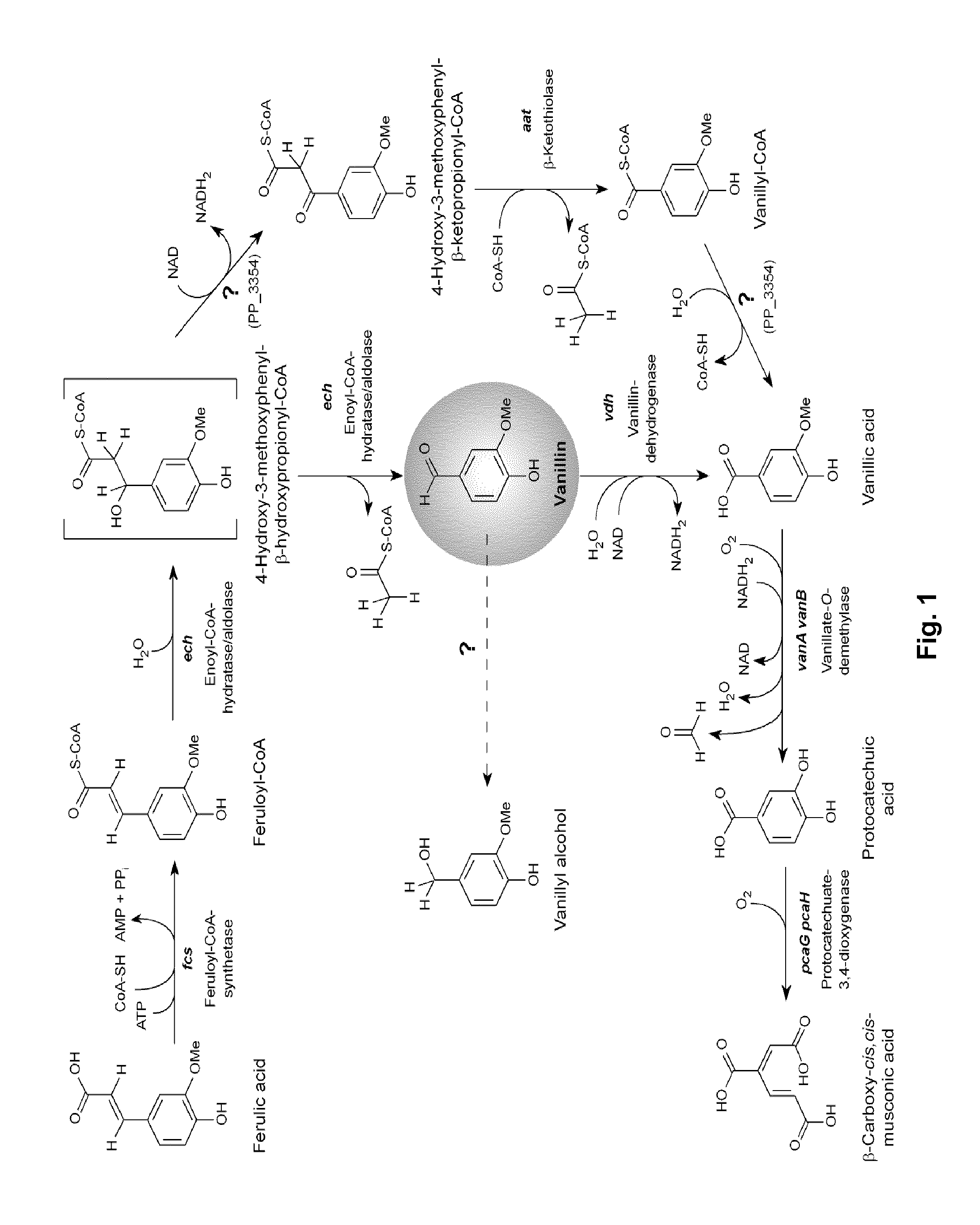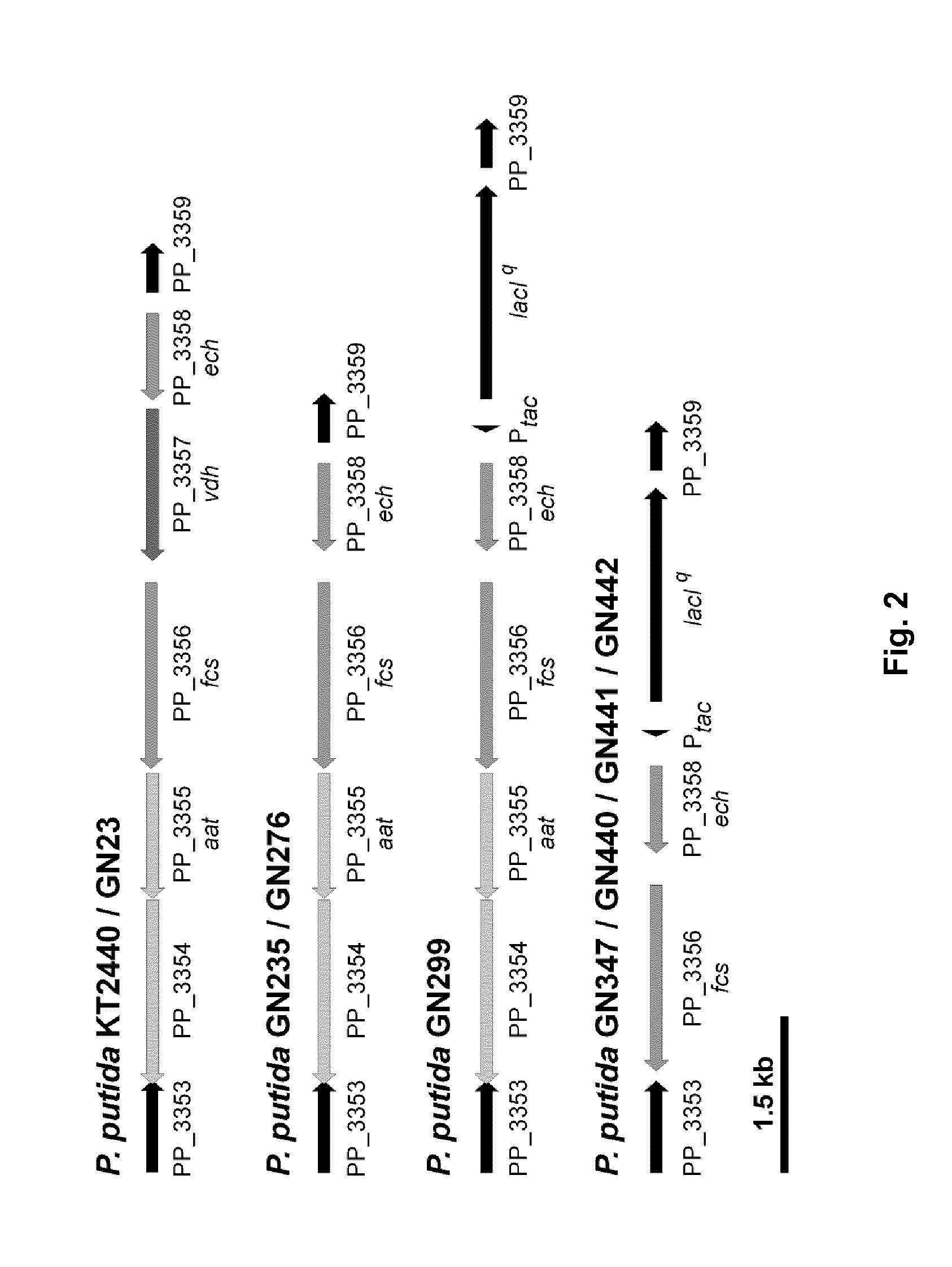Genetic engineering of pseudomonas putida kt2440 for rapid and high yield production of vanillin from ferulic acid
- Summary
- Abstract
- Description
- Claims
- Application Information
AI Technical Summary
Benefits of technology
Problems solved by technology
Method used
Image
Examples
example 1
Construction and Characterization of a P. putida KT2440 Mutant Unable to Grow on Vanillin as Sole Carbon Source
[0181]As reported previously (Overhage et al., 1999b; Plaggenborg et al., 2003), P. putida KT2440 is able to grow on ferulic acid as sole carbon source. Ferulic acid is metabolized in a few steps to vanillin, catalyzed by feruloyl-CoA-synthetase (PP_3356, fcs) and enoyl-CoA-hydratase / aldolase (PP_3358, ech). Vanillin in turn gets further degraded to vanillic acid by the vanillin dehydrogenase (PP_3357, vdh). The last step has to be prevented, if vanillin accumulation is desired. The chromosomal organization of these genes in P. putida KT2440 and other strains constructed in this invention is shown in FIG. 2.
[0182]With respect to industrial applications, we constructed P. putida strain GN23 with a deletion in the IapABC operon including the gene for the surface adhesion protein (PP_0168, lapA) using the previously described upp counterselection method (Graf and Altenbuchner,...
example 2
Bioconversion Assays of Strains GN23, GN235 and GN276
[0185]Resting cells of strains GN23 and GN235 were used for bioconversion assays. 10 mM of ferulic acid were added to the resting cells and the concentrations of ferulic acid, vanillin, vanillyl alcohol and vanillic acid were measured by HPLC taking samples at regular intervals during reaction time. The assay was stopped after 18 h conversion time. Both strains, GN23 and GN235, showed a rapid conversion of ferulic acid accompanied with a temporary accumulation of vanillic acid in the first 5 h (FIG. 4a,b). Furthermore, accumulation of vanillin, vanillyl alcohol and vanillic acid could not be observed in either of them.
[0186]A bioconversion assay of ferulic acid with GN276 (FIG. 4c) showed a decreased conversion rate of ferulic acid. Whereas with GN23 all of the applied ferulic acid (10 mM) was converted after 18 h, 2.4 mM could still be measured using GN276. In contrast to GN23 and GN235, GN276 accumulated 4.8 mM vanillin after 5 ...
example 3
Increase of Chromosomal Ech-Fcs Expression Leads to High Conversion Rates and High Vanillin Molar Yields
[0187]Feruloyl-CoA-synthetase (fcs) and enoyl-CoA-hydratase / aldolase (ech) catalyze the conversion of ferulic acid to vanillin. We assumed that the conversion rate of ferulic acid should be directly proportional to the number of these two metabolic enzymes in the cell, if the required cofactors, ATP and CoA-SH, are available in excess or regenerated. Using the upp counterselection system, the strong tac promoter (Ptac) and lacIq were integrated immediately upstream of ech and fcs in the chromosome of GN276 in order to control the expression of these two genes (FIG. 2).
[0188]The resulting strain was designated GN299. After induction of ech and fcs expression with IPTG, bioconversion assays were conducted with this strain. After 5 h, nearly all of the 10 mM ferulic acid were converted to 1.1 mM vanillyl alcohol, 0.2 mM vanillic acid and 8.3 mM of vanillin, corresponding to a molar y...
PUM
| Property | Measurement | Unit |
|---|---|---|
| Temperature | aaaaa | aaaaa |
| Molar density | aaaaa | aaaaa |
| Concentration | aaaaa | aaaaa |
Abstract
Description
Claims
Application Information
 Login to View More
Login to View More - R&D
- Intellectual Property
- Life Sciences
- Materials
- Tech Scout
- Unparalleled Data Quality
- Higher Quality Content
- 60% Fewer Hallucinations
Browse by: Latest US Patents, China's latest patents, Technical Efficacy Thesaurus, Application Domain, Technology Topic, Popular Technical Reports.
© 2025 PatSnap. All rights reserved.Legal|Privacy policy|Modern Slavery Act Transparency Statement|Sitemap|About US| Contact US: help@patsnap.com



